Even if you’ve never made homemade bread or worked with yeast before, this homemade crusty artisan bread is for you. It’s the perfect beginner recipe because it only requires 4 ingredients without any special pans or mixer, there’s no kneading or complicated shaping involved, and 95% of the work is hands-off. Bread masters will appreciate this recipe too because it delivers with delicious flavor, a slightly crisp and mega chewy crust, and those signature soft holes inside like ciabatta or French bread.
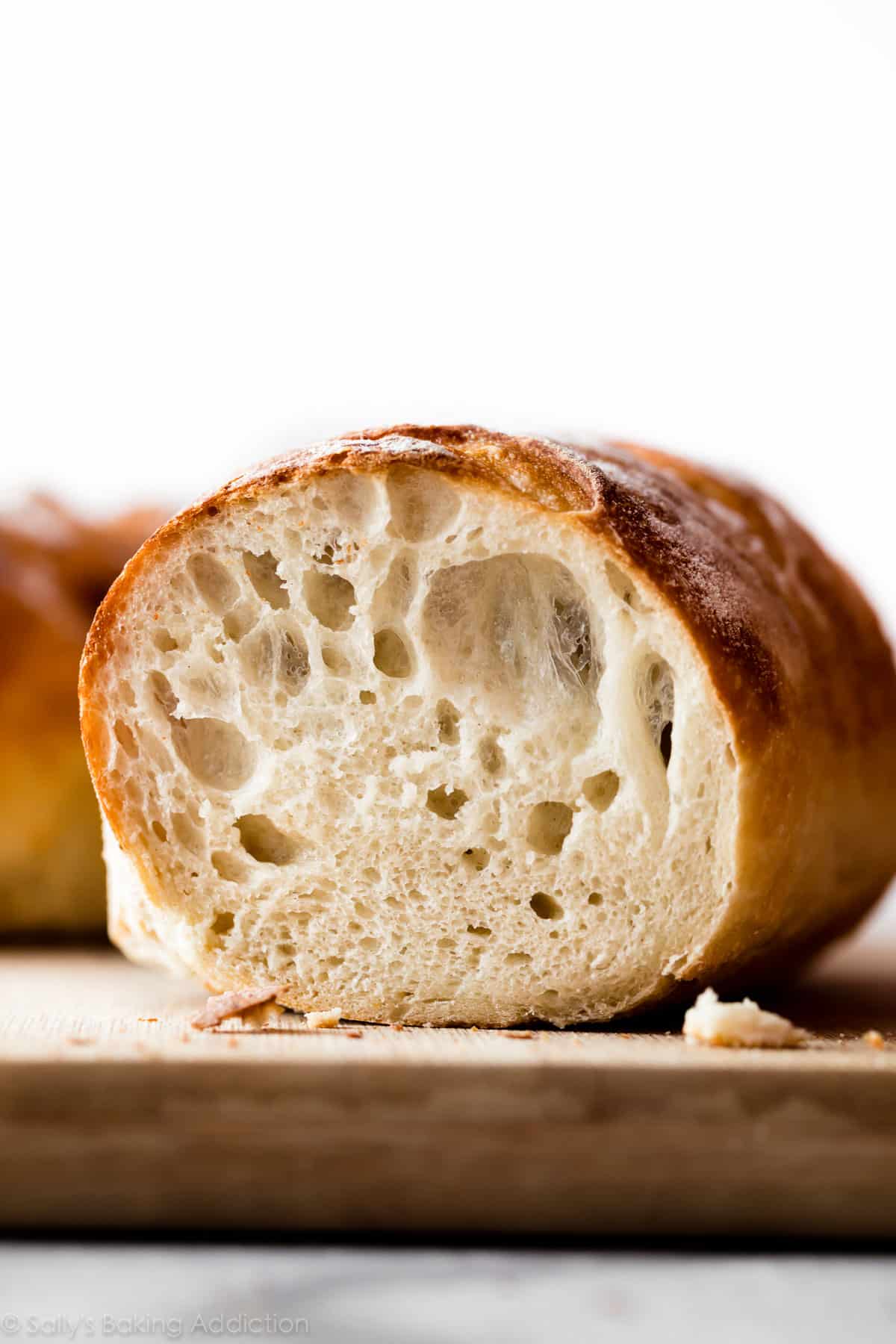
Bread Beginners—Start Here
Have you ever wanted to master homemade bread? Real, crusty, chewy, delicious bakery-style loaves that taste incredible with dips, soups, sauces, and comforting dinners? This recipe is where you start. This artisan bread is for beginners, but even bread masters will appreciate its flavor and ease. It’s so fresh, so flavorful, and so surprisingly easy because it basically makes itself.
You only need 4 ingredients without any special pans or mixer, there’s no kneading, no poolish or dough starter required, and you can add herbs, cheeses, and spices to make a variety of bread flavors.
This base recipe will soon be on repeat in your kitchen. After you realize how easy it is to make real homemade bread, you’ll find any excuse to bake a loaf.
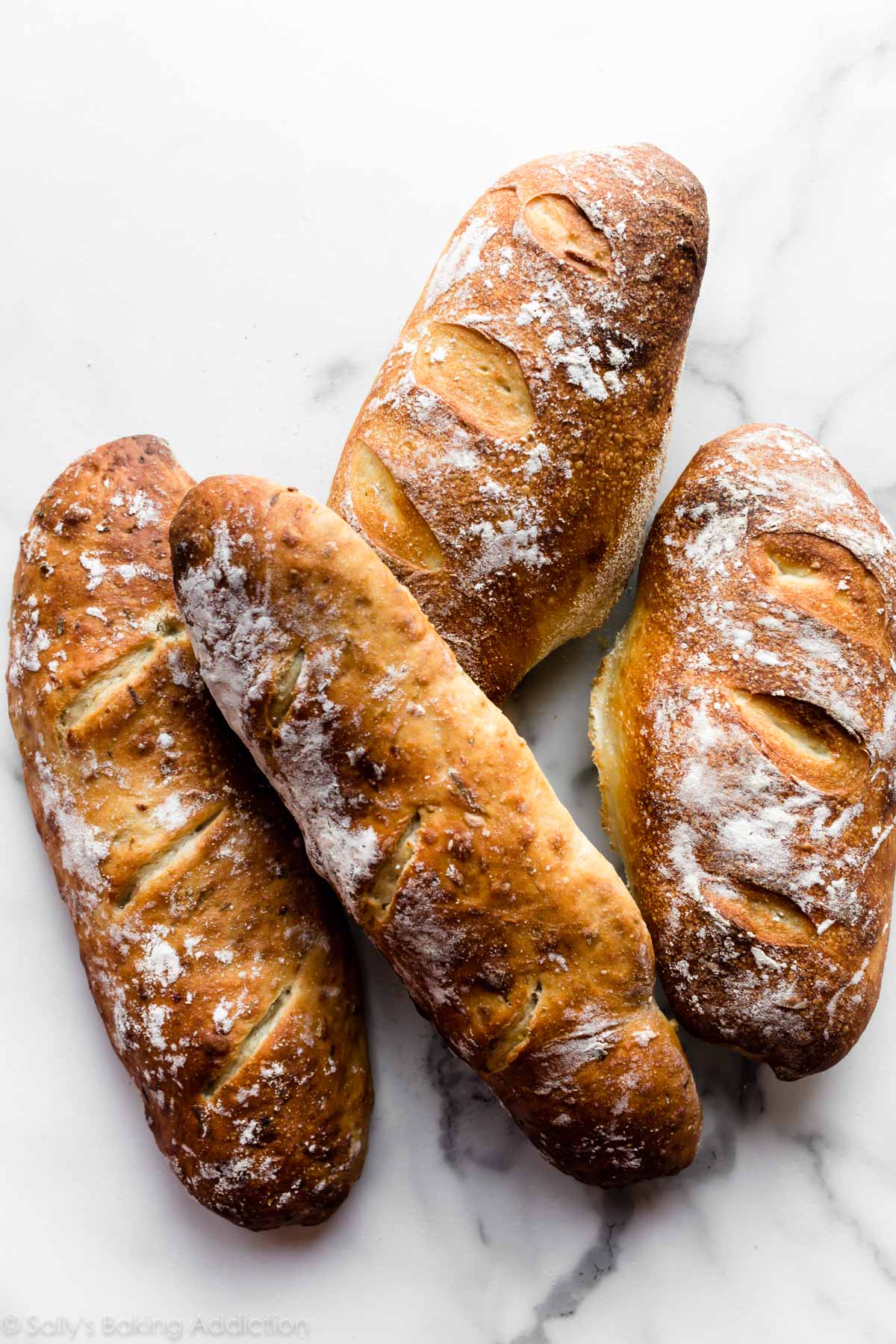
What is Homemade Artisan Bread?
When it comes to bread, the term “artisan” doesn’t mean 1 particular thing. But generally, artisan bread is homemade, fresh, crusty, and deliciously rustic looking. An artisan is a skilled worker, one who works with their hands. But ironically, there isn’t much “work” involved with this recipe.
Why You’ll Love This Bread
- Easier than you ever imagined
- Soft + flavorful
- Chewy, slightly crisp crust
- Shape however you want
- No special pans, poolish, or dough starter required
- Only 4 ingredients
- You decide the length of time it rests
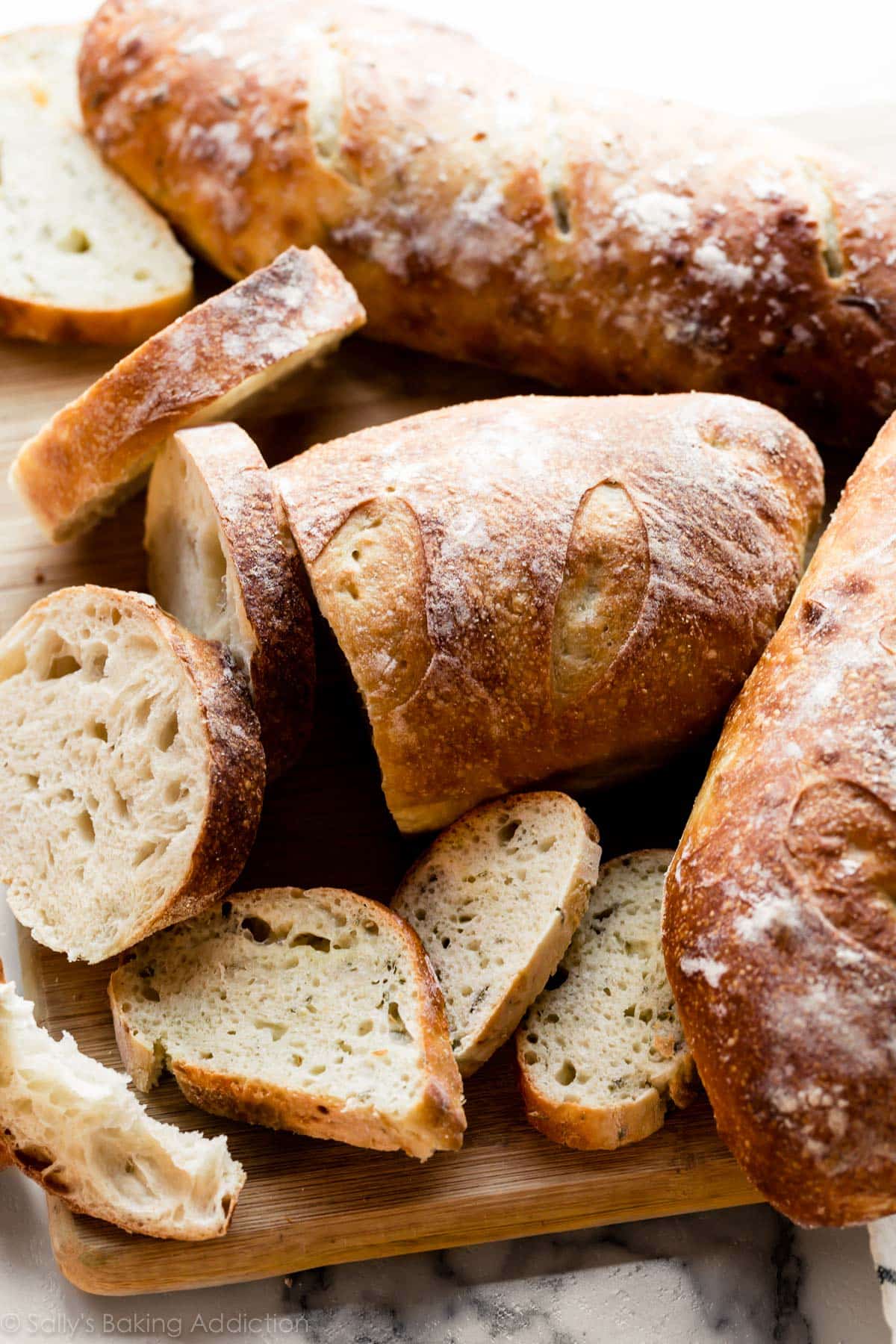
Homemade Artisan Bread Video Tutorial
Like sandwich bread, whole wheat bread, focaccia, homemade English muffins, seeded oat bread, and homemade bagels—the process is surprisingly easy. If you’re new to yeast, reference my Baking with Yeast Guide for answers to common yeast FAQs.
Only 4 Ingredients
The crustier and chewier the bread, the less fat in the dough—also known as a “lean dough.” We’re using a lean dough for our artisan loaf today. (If you’re curious, a “rich dough” is a soft bread dough with the presence of fat, such as butter and eggs—the kind we need for overnight cinnamon rolls and honey butter rolls.) Without fat, we’re left with the basics.
- Bread Flour: While you can use all-purpose flour in this recipe, I strongly recommend using bread flour. Just like when we make olive bread, bread flour produces a stronger, chewier bread and that makes a big difference in recipe with only 3 other ingredients.
- Instant Yeast: Instant yeast is key in this recipe. While you can use active dry if that’s all you have, any quick rise or instant yeast will produce flavorful results in less time. I use more yeast in this recipe compared to my cranberry nut no-knead bread and no-knead jalapeño cheddar bread. Why? Those doughs rest and rise at room temperature. However, for more flavor and just as much rise, I use more yeast and let the this dough rest in the refrigerator. (Cool air slows the fermentation process.)
- Salt: You can’t make good bread without salt and for best flavor, I recommend a coarse salt, such as coarse sea salt. I find the bread’s flavor lacking with regular table salt.
- Water: I normally encourage you to use warm liquid with yeast because warm liquid helps the yeast work faster. However, use cool or room temperature water here. Not freezing cold, not super warm—cool to touch. 70°F (21°C) is great, but the exact temperature doesn’t matter as long as it’s not hot or warm. The cooler the water, the longer the dough takes to rise and, usually, the better the bread’s flavor. (This is important since there are so little ingredients to add substantial flavor!) We use the same cool water method for no knead honey oat bread.
- Optional Cornmeal: Dusting the pan with cornmeal adds a pop of flavor and a little crunch to the bottom crust. This is completely optional. If you have it, use it. If you don’t have it, don’t worry about it.
You can also add herbs and seasonings such as garlic, rosemary, dill, chopped onion, jalapeño, shredded cheese, chopped nuts, dried cranberries, etc. My no yeast bread is the quick bread alternative here—you can add flavors to that loaf, too!
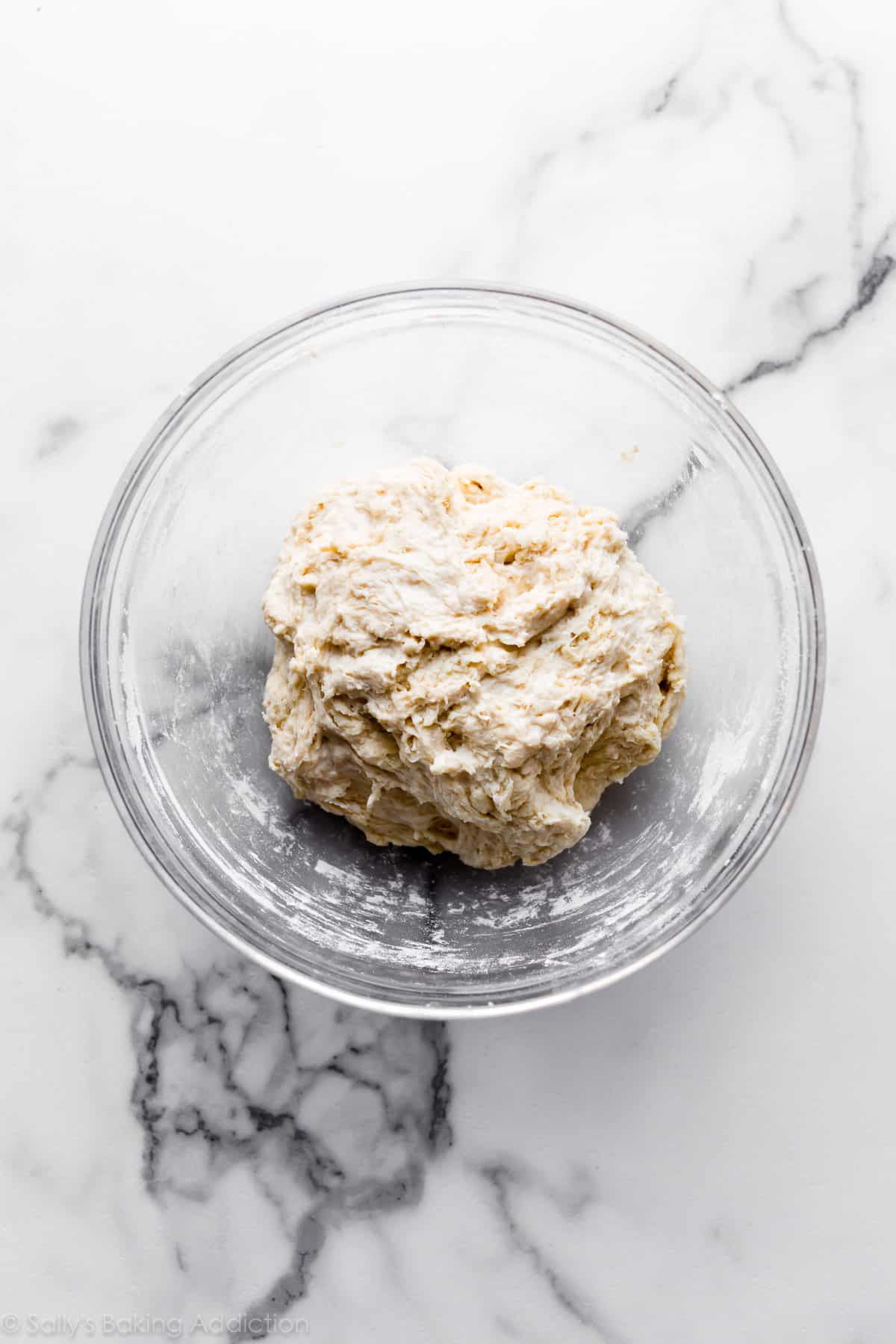
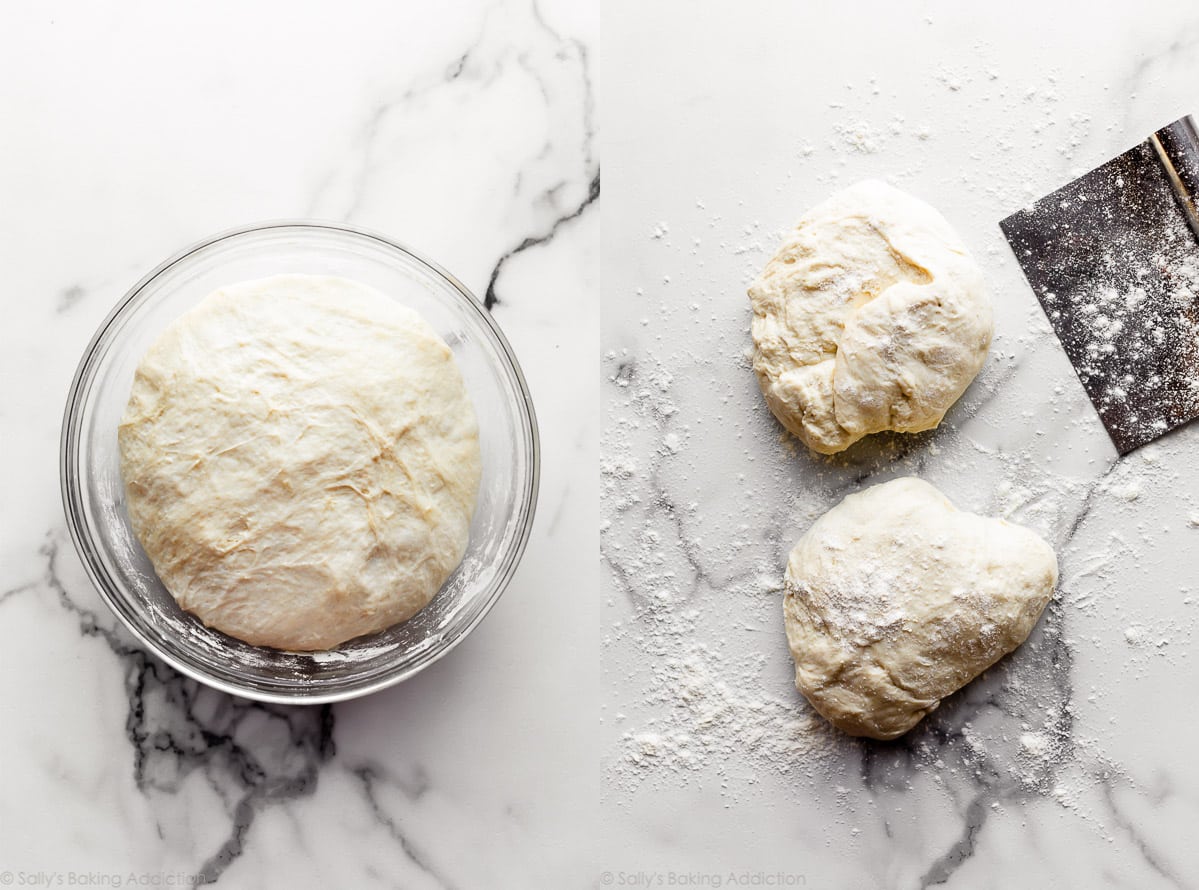
Baker’s Tip: Avoid adding too much flour to the dough as you work with it. The stickier it is—and the longer it sits in the refrigerator—the more likely you’ll have those big airy pockets of air in the crumb.
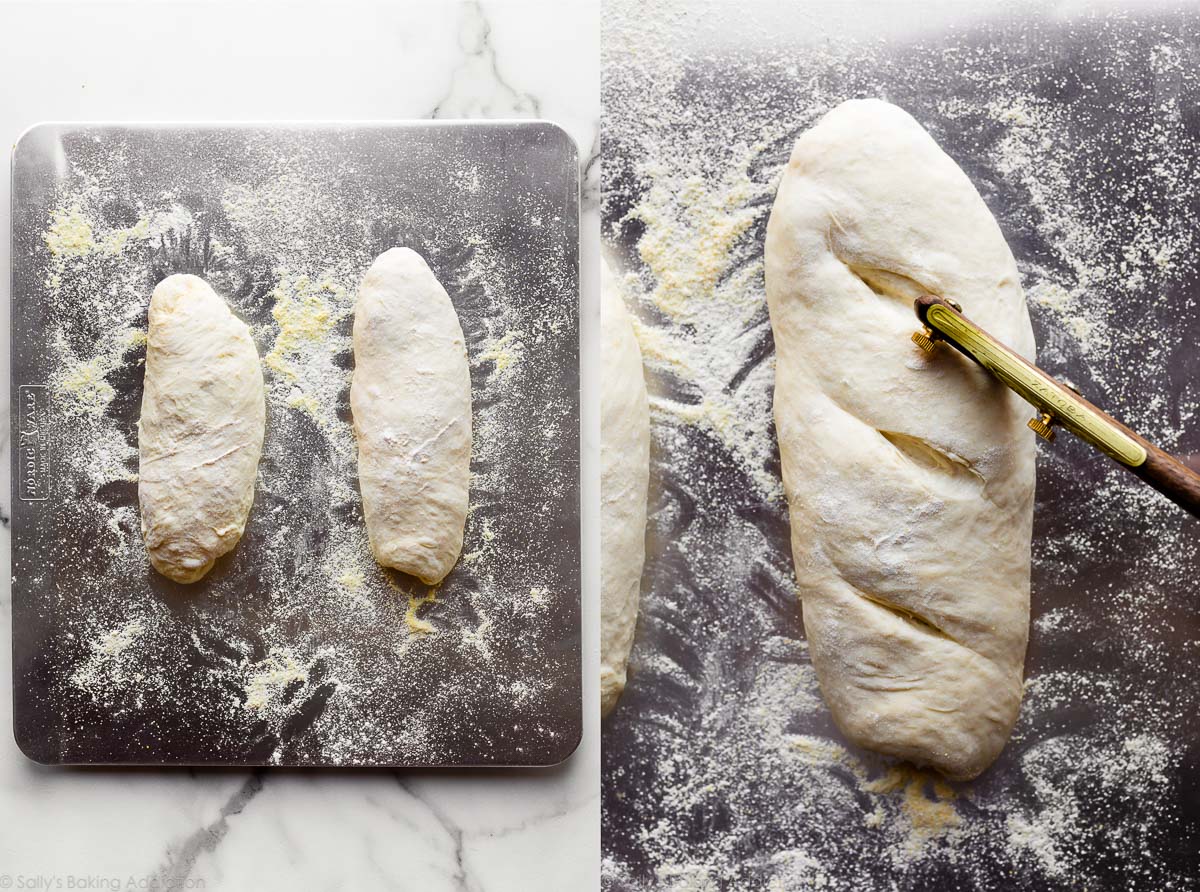
How to Make Homemade Artisan Bread in 5 Steps
- Mix the dough ingredients together. At first the dough will seem very dry and shaggy and you’ll question if it will even come together. But it will. Use a spatula at first, then switch to your hands to ensure all of the flour is moistened. The dough is actually a little sticky after it’s thoroughly mixed.
- Let it rise at room temperature for 2-3 hours. Cover the dough and let it rise at room temperature for about 2-3 hours until doubled in size.
- Use right away or refrigerate. After 2-3 hours, you can immediately continue with the next step. However, for ideal flavor and texture, I strongly recommend letting the dough sit in the refrigerator for at least 12 hours and up to 3 days. Yes, 3 full days! I usually only let it rest for about 18 hours. During this crucial step, the cold air slows the fermentation process and adds so much flavor and texture. So, you can bake bread in 2-3 hours or in 3 days. The longer it sits, the better it tastes. 🙂
- Shape into 2 loaves or 1 boule. Rest as oven preheats. You can shape the bread into a round loaf (boule) or two longer loaves. I usually make 2 longer loaves side-by-side on a flat baking sheet, about 9×3 inches each. Score with a sharp knife or bread lame. Preheat the oven to a very hot 475°F (246°C). The extremely hot air will immediately set the crust so the bread rises up instead of spreading all over. To help ensure a crispier crust, after the oven pre-heats—pour boiling water into a metal or cast iron baking pan/dish on the bottom oven rack. Immediately place the dough inside and shut the oven door to trap the steam. The steam will help create that coveted crisp crust. If you have a dutch oven, shape the dough into 1 round loaf, and bake it inside the dutch oven with the lid on.
- Bake until golden brown, about 20-25 minutes. Gently tap the loaves because if they sound hollow, they’re done.
Look at those deliciously soft holes inside! Reminds me of ciabatta or a French baguette, both of which can be a little more complicated to make.
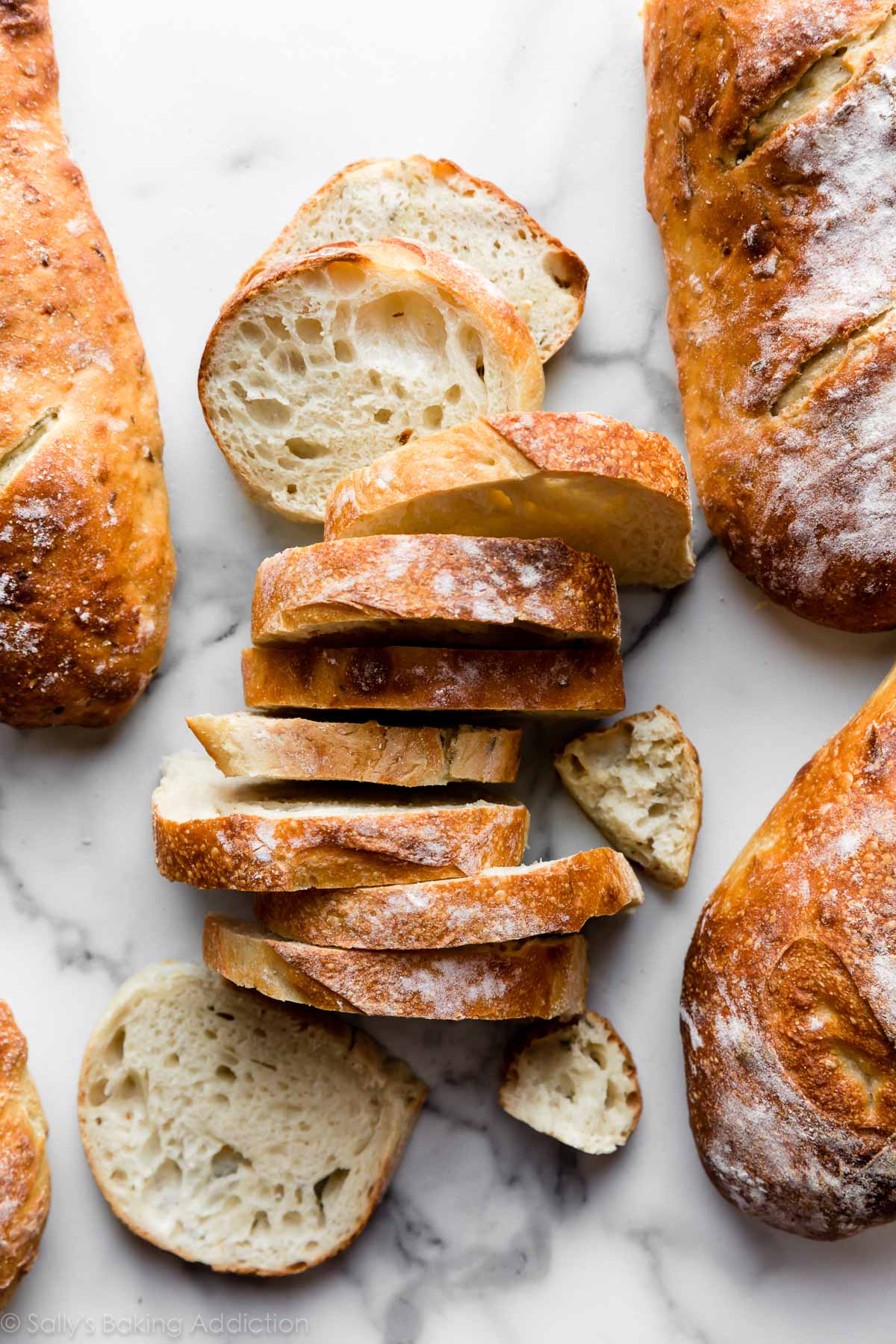
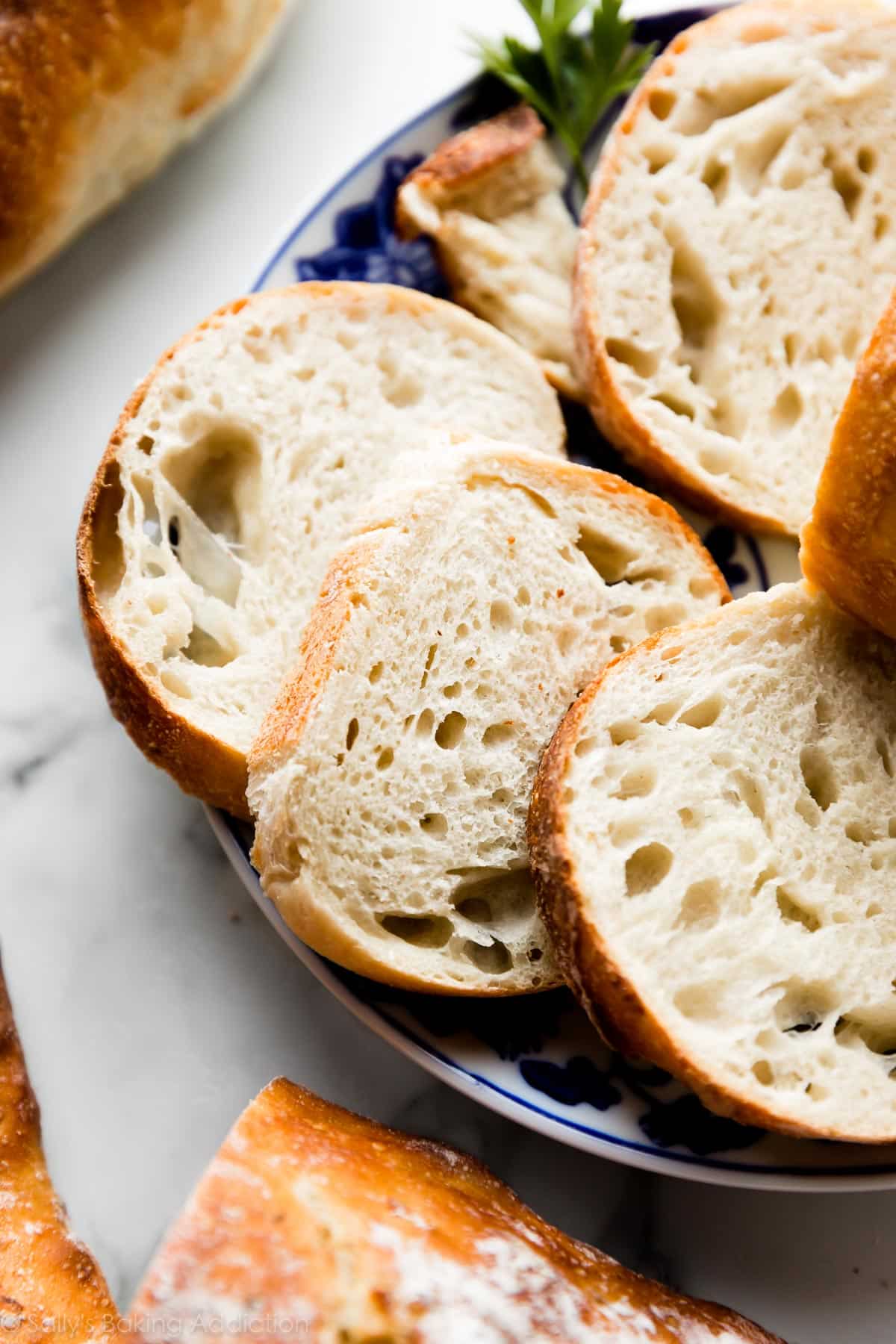
Serve Artisan Bread With
- Slather with homemade honey butter
- Slice and dunk in crab dip, beer cheese dip, or roasted garlic bacon spinach dip
- Serve alongside slow cooker chicken chili or pumpkin chili
- As a dunker for minestrone soup or creamy chicken noodle soup
- With a big bowl of mac & cheese
- Use for my goat cheese & honey crostini
- It’s the perfect starch in breakfast casserole
- With anything because homemade bread is everything’s best friend
See Your Homemade Artisan Bread!
Many readers tried this recipe as part of a baking challenge! Feel free to email or share your recipe photos with us on social media. 🙂
Print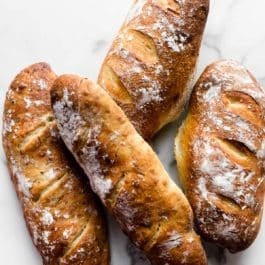
Homemade Artisan Bread Recipe
- Prep Time: 4 hours
- Cook Time: 25 minutes
- Total Time: 4 hours, 25 minutes
- Yield: 2 8-inch loaves
- Category: Bread
- Method: Baking
- Cuisine: American
Description
Even if you’ve never made homemade bread or worked with yeast before, this homemade artisan bread is for you. Watch the video tutorial below and review the recipe instructions and recipe notes prior to beginning. If you’re new to working with yeast, reference my Baking with Yeast Guide for answers to common yeast FAQs.
Ingredients
- 3 and 1/4 cups (about 430g) bread flour (spooned & leveled), plus more for hands and pan
- 2 teaspoons (about 6g) instant yeast
- 2 teaspoons (about 9g) coarse salt (see note)
- 1 and 1/2 cups (360ml) water, close to room temperature at about 70°F (21°C)
- optional: cornmeal for dusting pan
Instructions
- In a large un-greased mixing bowl, whisk the flour, yeast, and salt together. Pour in the water and gently mix together with a silicone spatula or wooden spoon. The dough will seem dry and shaggy, but keep working it until all the flour is moistened. If needed, use your hands (as I do in the video tutorial below) to work the dough ingredients together. The dough will be sticky. Shape into a ball in the bowl as best you can.
- Keeping the dough in the bowl, cover the dough tightly with plastic wrap or aluminum foil and set on the counter at room temperature (honestly any normal room temperature is fine!). Allow to rise for 2-3 hours. The dough will just about double in size, stick to the sides of the bowl, and have a lot of air bubbles.
- You can continue with step 4 immediately, but for absolute best flavor and texture, I strongly recommend letting this risen dough rest in the refrigerator for at least 12 hours and up to 3 days. Place covered dough in the refrigerator for 12 hours – 3 days. I usually let it rest in the refrigerator for about 18 hours. The dough will puff up during this time, but may begin to deflate after 2 days. That’s fine and normal—nothing to worry about.
- Lightly dust a large nonstick baking sheet (with or without rims and make sure it’s nonstick) with flour and/or cornmeal. Turn the cold dough out onto a floured work surface. Using a sharp knife or bench scraper, cut dough in half. Some air bubbles will deflate as you work with it. Place dough halves on prepared baking sheet. Using floured hands, shape into 2 long loaves about 9×3 inches each (doesn’t have to be exact) about 3 inches apart. Loosely cover and allow to rest for 45 minutes. You will bake the dough on this prepared baking sheet.
- During this 45 minutes, preheat the oven to 475°F (246°C).
- When ready to bake, using a very sharp knife or bread lame (some even use kitchen shears), score the bread loaves with 3 slashes, about 1/2 inch deep. (“Score” = shallow cut.) If the shaped loaves flattened out during the 45 minutes, use floured hands to narrow them out along the sides again.
- Optional for a slightly crispier crust: After the oven is preheated and bread is scored, place a shallow metal or cast iron baking pan or skillet (I usually use a metal 9×13-inch baking pan) on the bottom oven rack. Carefully and quickly pour 3-4 cups of boiling water into it. Place the scored dough/baking pan on a higher rack and quickly shut the oven, trapping the steam inside. The steam helps create a crispier crust.
- Place the shaped and scored dough (on the flour/cornmeal dusted pan) in the preheated oven on the center rack. Bake for 20-25 minutes or until the crust is golden brown. Gently tap the loaves—if they sound hollow, the bread is done. For a more accurate test of doneness, the bread is done when an instant read thermometer inserted in the center reads 195°F (90°C).
- Remove the bread from the oven and allow to cool for at least 5 minutes before slicing and serving. Store leftovers loosely covered at room temperature for up to 5 days or in the refrigerator for up to 10 days.
Notes
- Make Ahead & Freezing Instructions: The dough can sit in the refrigerator for up to 3 days, so this is a wonderful recipe to begin ahead of time. You can also bake the bread, allow it to cool, and freeze for up to 3 months. Thaw in the refrigerator and allow to come to room temperature before serving. You can also freeze the dough. Complete the recipe through step 3. Wrap in plastic wrap and place in a freezer-friendly container. To bake, allow dough to thaw overnight in the refrigerator, or for 2-3 hours at room temperature. Continue with step 4 and the rest of the recipe instructions.
- Special Tools (affiliate links): Glass Mixing Bowls | Silicone Spatula or Wooden Spoon | Baking Sheets | 2-cup Measuring Cup | Bread Lame | Instant Read Thermometer
- Flour: For absolute best flavor and chewy texture, I strongly recommend using bread flour. You can use a 1:1 substitution of all-purpose flour in a pinch with no other changes to the recipe. I recommend avoiding whole wheat flour in this dough. If necessary, use half bread flour and half whole wheat flour. The bread will taste a bit dense.
- Yeast: You can use instant or active dry yeast, but I highly recommend an instant (aka “rapid rise” or “quick rise” yeast). The bread will rise faster. I usually use Platinum yeast by Red Star, which is an instant yeast. 2 teaspoons is a little less than 1 standard packet. If using active dry yeast, there are no changes needed to the recipe. The rise time in step 2 may take longer.
- Salt: Use a coarse salt, such as coarse sea salt, in this bread. I find the flavor slightly lacking when using regular table fine salt. If you only have fine salt, reduce to 1 and 1/2 teaspoons.
- Water: Use cool water. 70°F (21°C) is great, but the exact temperature doesn’t matter as long as it’s not hot or warm.
- Round Loaf: If you want to shape the dough into a boule (round loaf) simply shape into a round ball instead of 2 loaves in step 4. Baking instructions are the same, but the loaf will take a few extra minutes in the oven. If you want to bake the boule in a dutch oven, see next note.
- Using a Dutch Oven: Follow this dough recipe through step 3, then follow the simple shaping/baking instructions (steps 2-5) in my Cranberry Nut No Knead Bread recipe including using the parchment paper. If your parchment paper can’t withstand heat this high, you can either lower the oven temperature and bake the bread for longer or grease the Dutch oven instead.
- Using a pizza stone: If you want to bake your bread loaves on a pizza stone, place pizza stone in the preheating oven. In step 8, place the shaped and scored dough on your preheated pizza stone. If the bottom of the shaped dough is pretty sticky, dust the hot pizza stone with some extra cornmeal. Bake as directed.
- No Nonstick Pan: If you don’t have a nonstick baking sheet, line it with parchment paper instead. Coat with a dusting of flour and/or cornmeal before placing the dough on top. Parchment paper can burn, so it’s best to check the box to see how much heat yours can tolerate. Lower your oven heat if necessary and bake the bread for longer until golden brown and when gently tapped, sound hollow.
- Flavor ideas: Before pouring in the water in step 1, add any of the following ingredients/combination of ingredients to the dry ingredients in the bowl: 4 cloves minced garlic + 3 Tablespoons chopped rosemary, 3 Tablespoons your favorite fresh herb (chopped), 1 cup your favorite shredded cheese, a diced jalapeño, 3/4 – 1 cup dried cranberries and/or chopped nuts, 2 teaspoons garlic powder, etc.
- Reference my Baking with Yeast Guide for answers to common yeast FAQs.
- Recipe adapted from King Arthur Flour & Red Star Yeast, similar method originally from Jim Lahey.
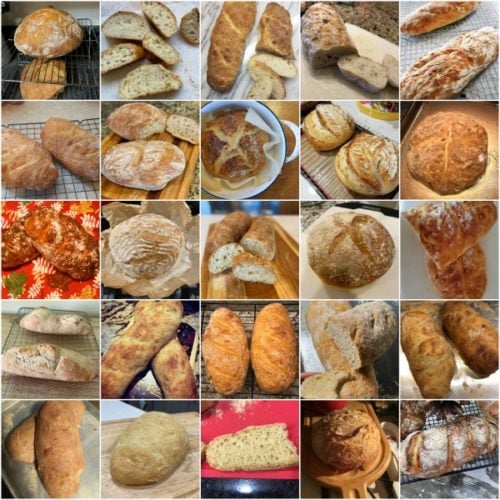
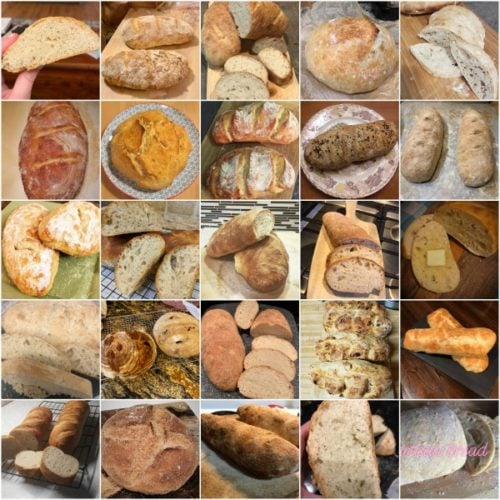
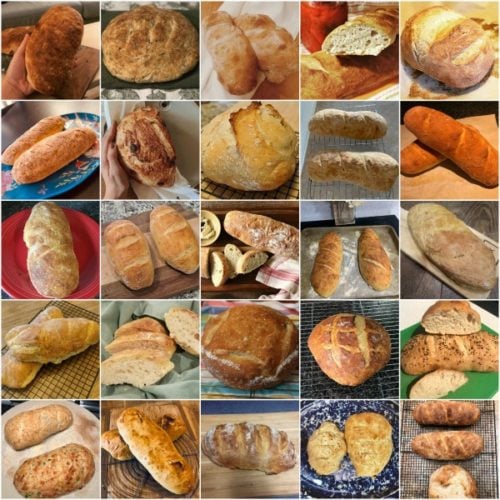
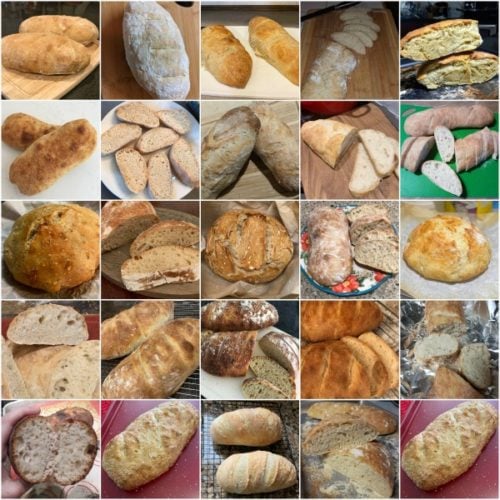
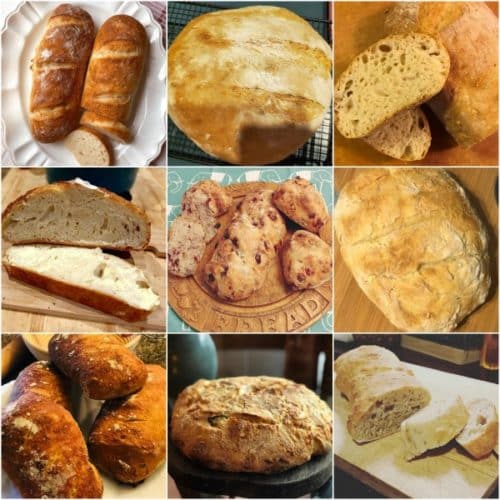
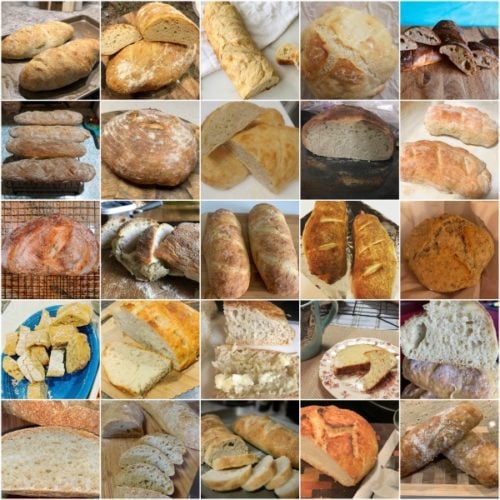
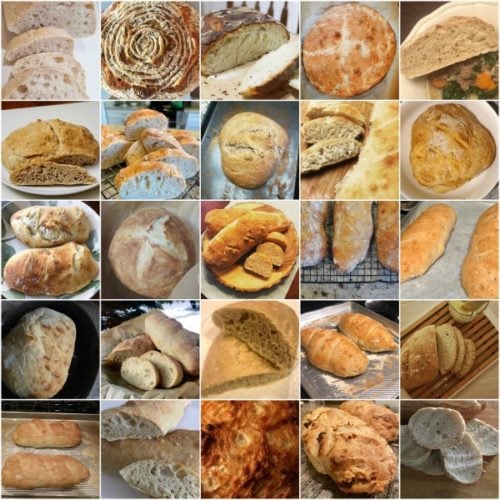
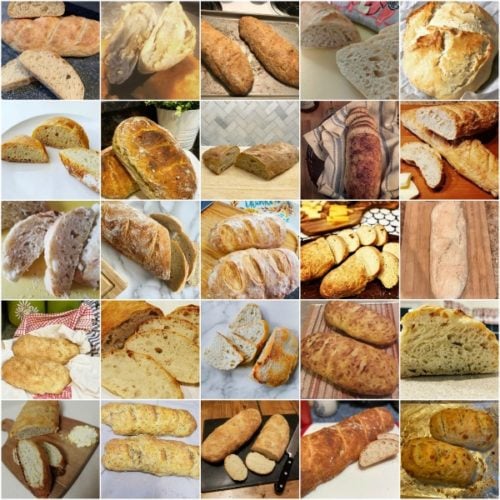
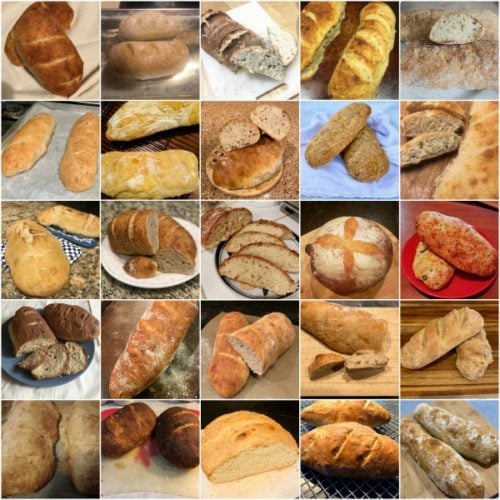
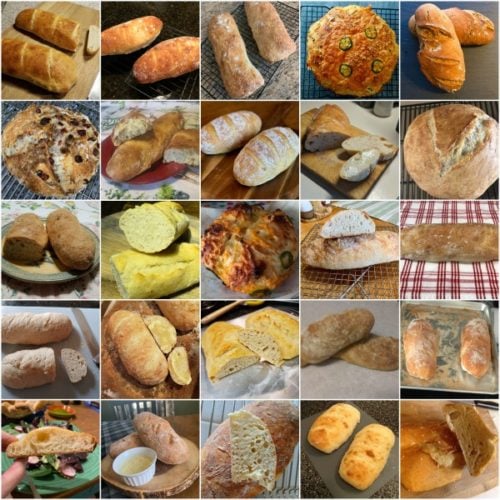
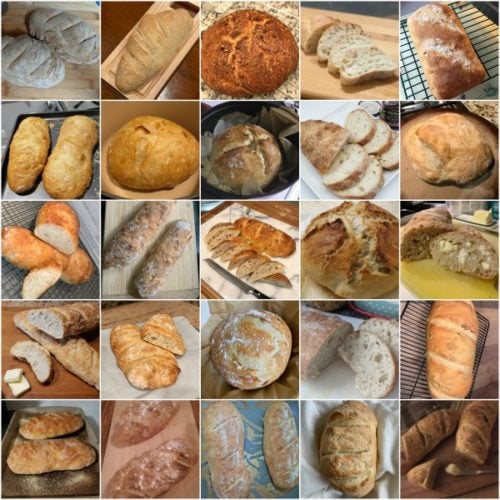
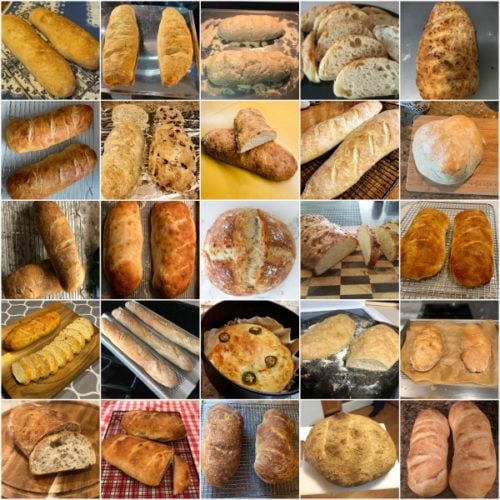
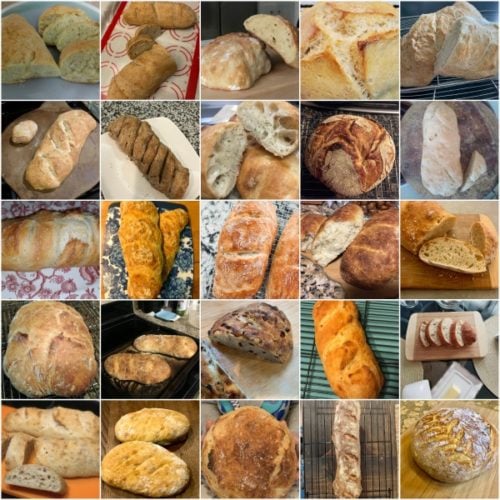
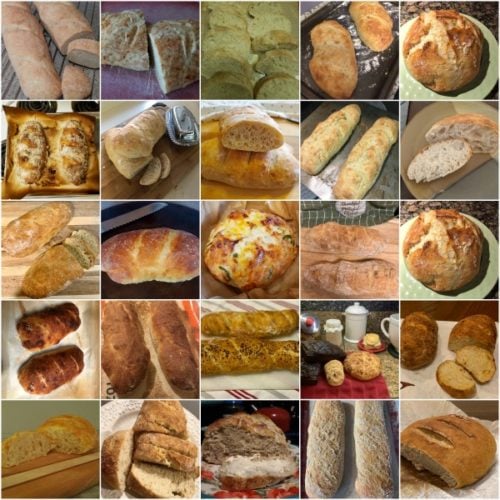
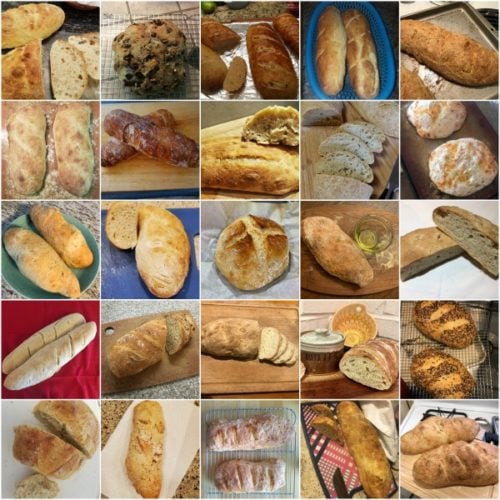
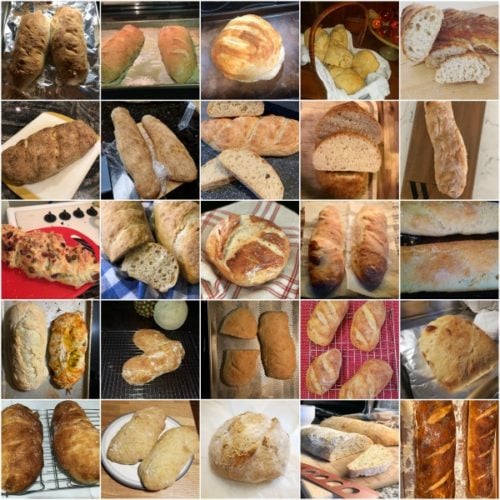

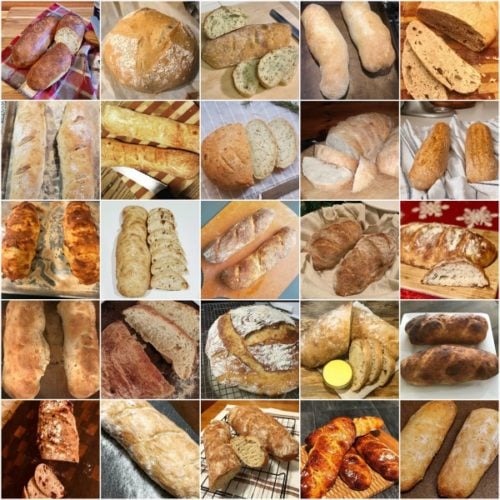
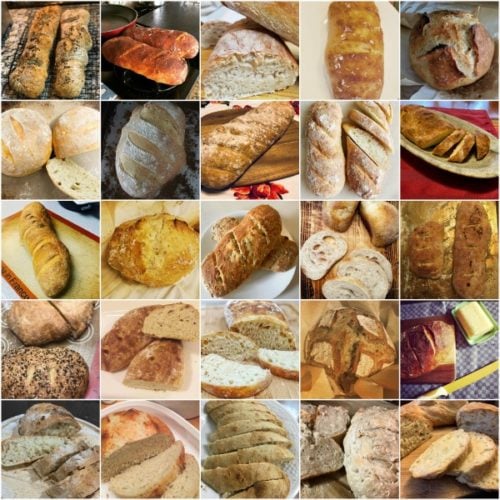
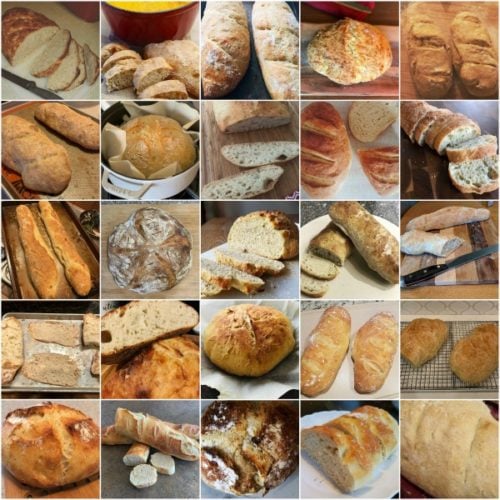
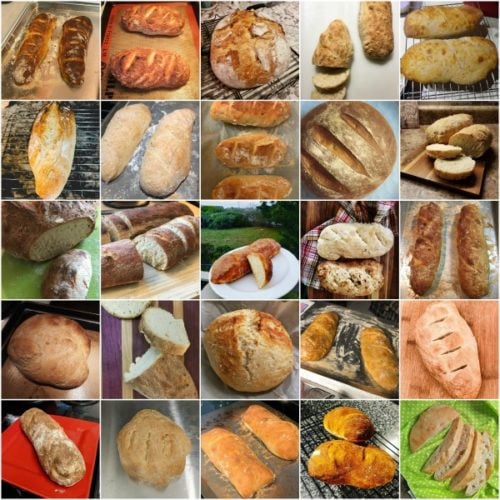
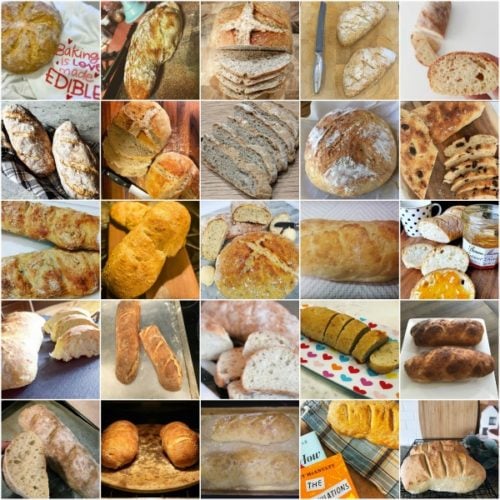
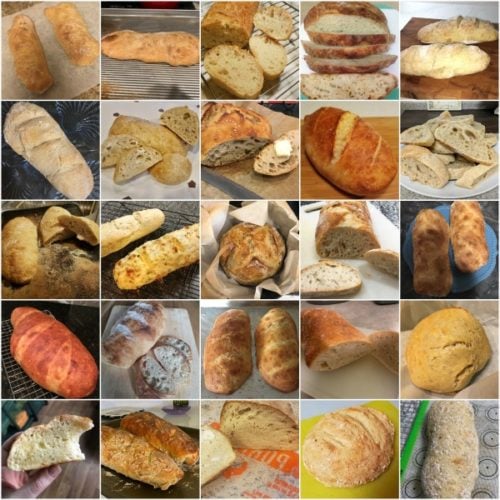
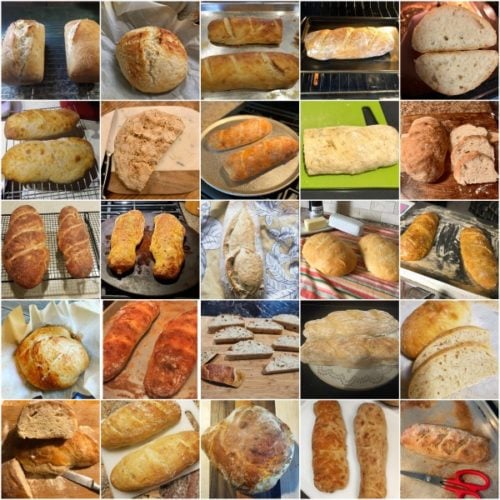
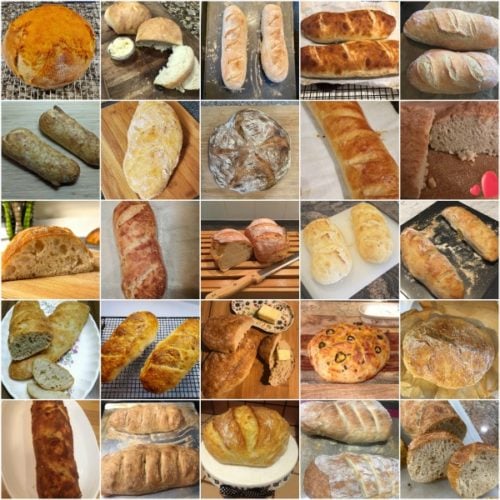
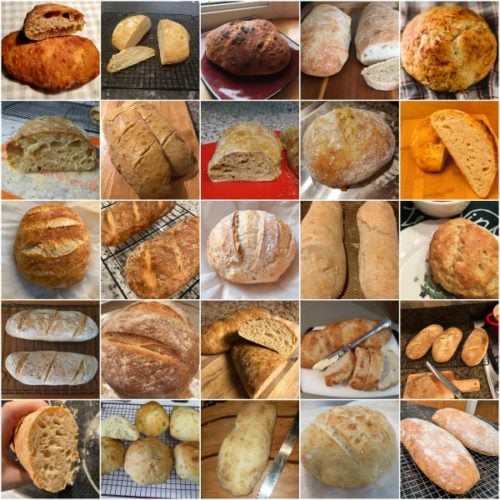
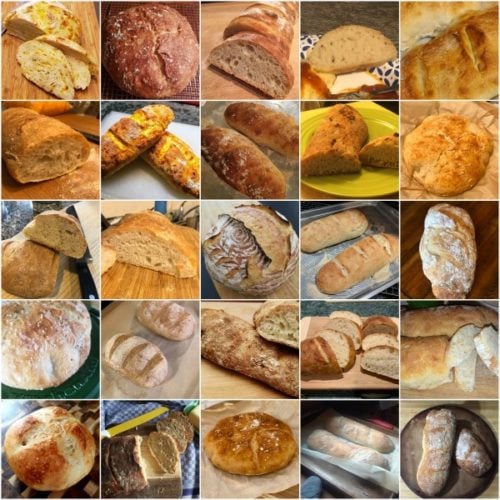
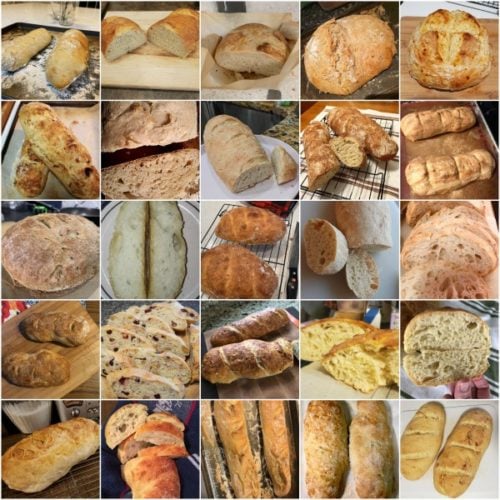
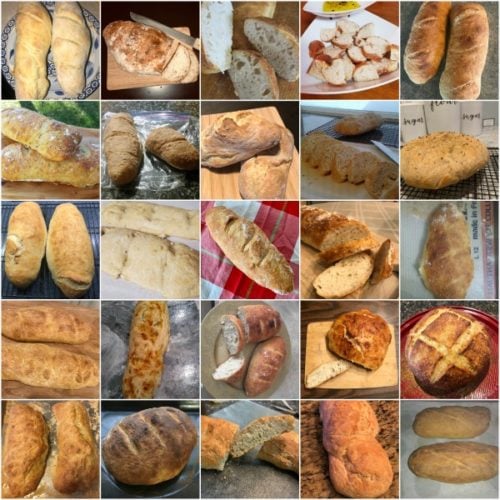

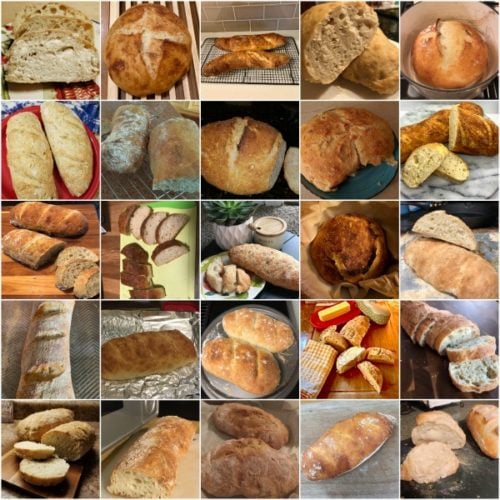
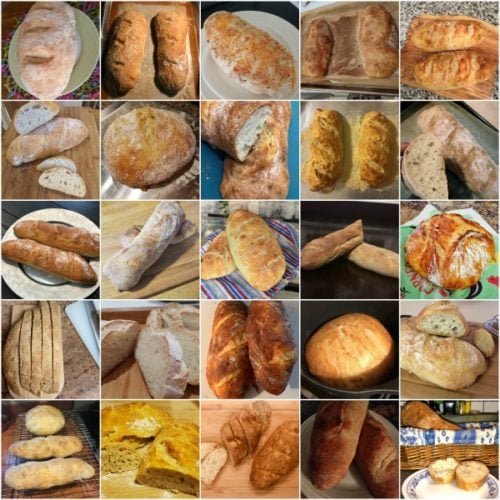
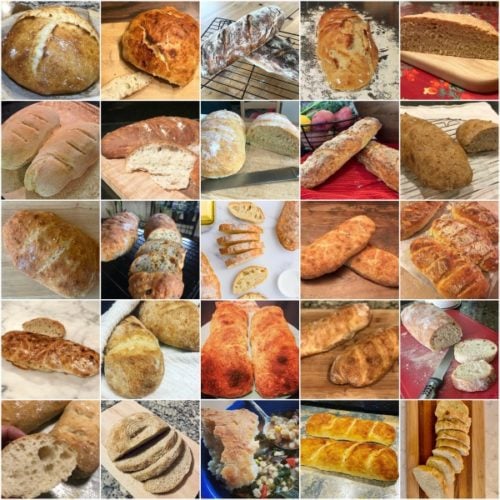
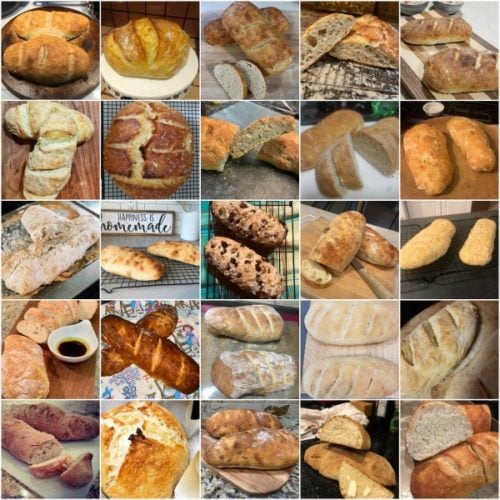
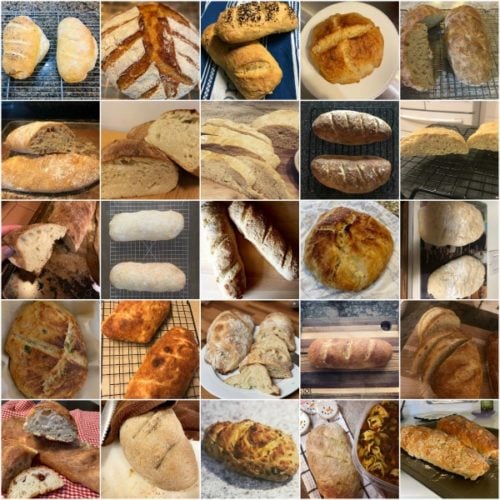
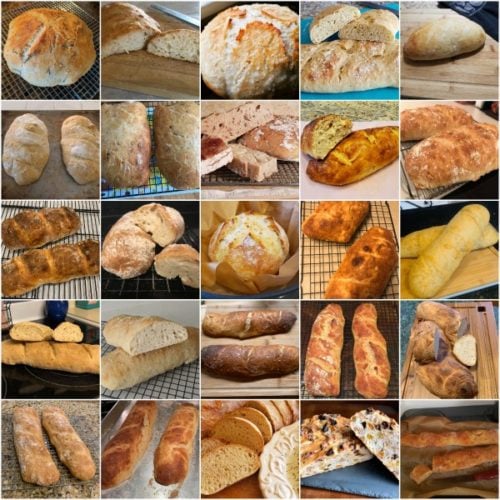
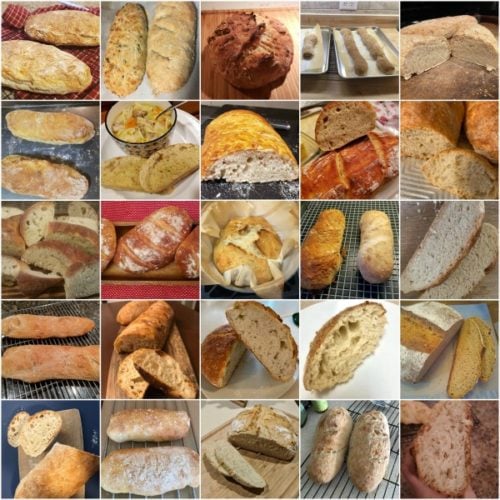
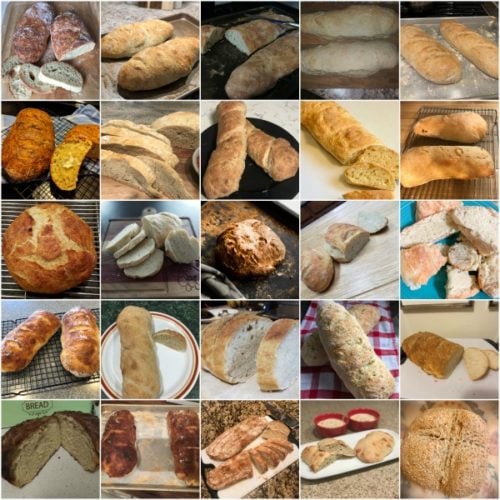
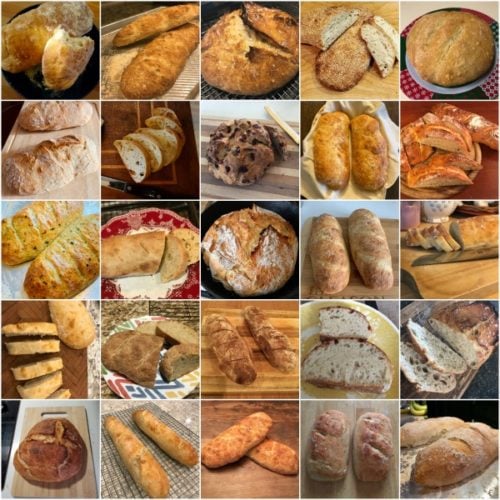
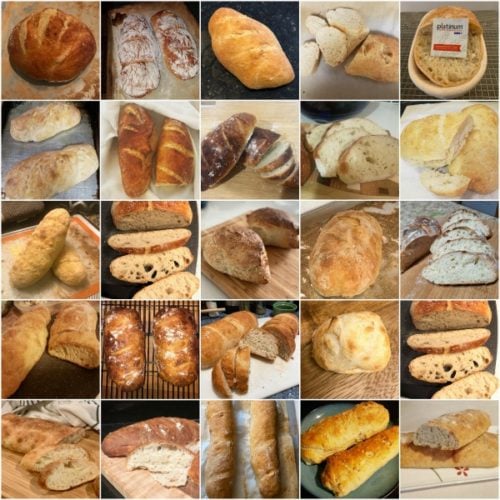
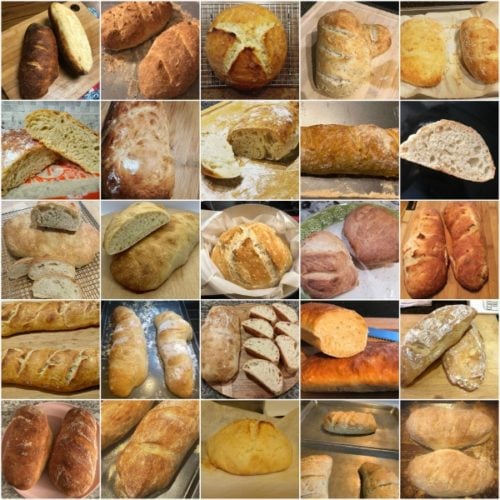
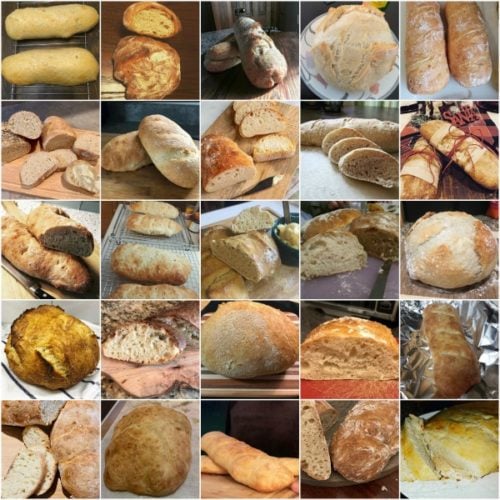
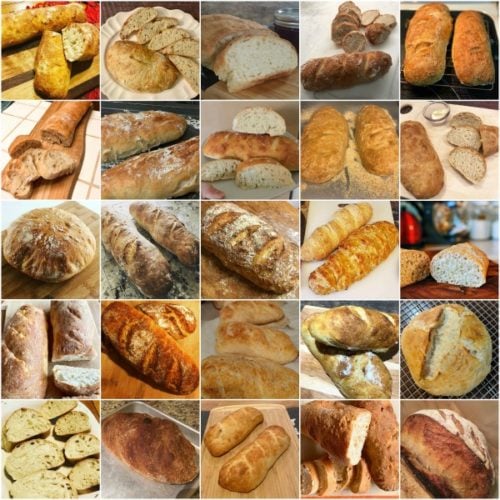
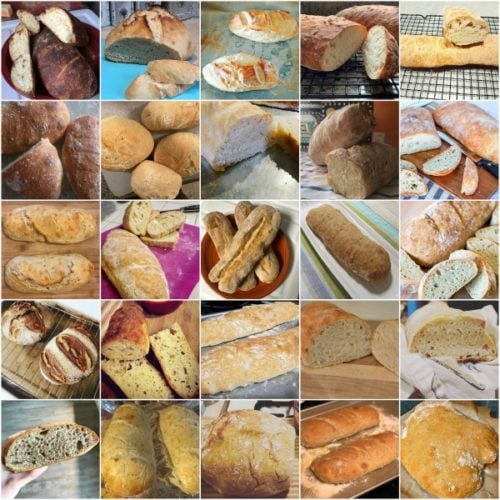
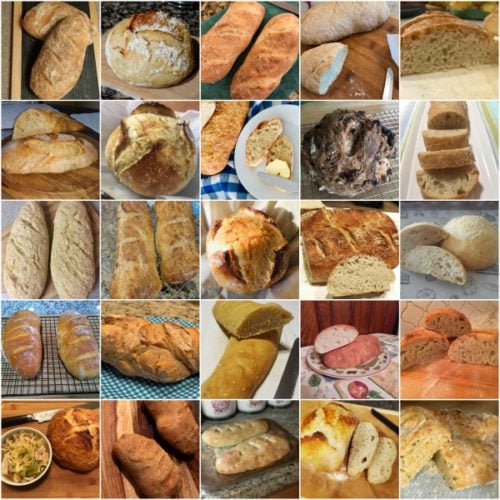
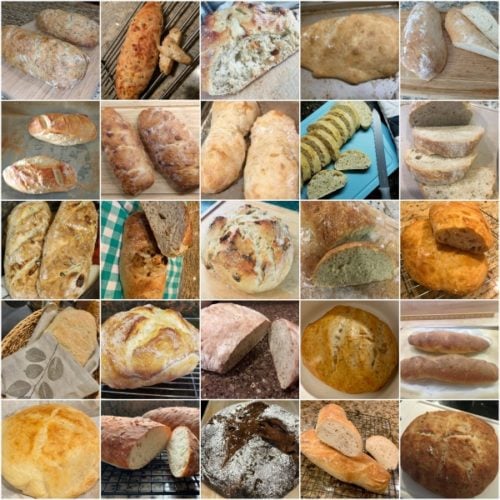
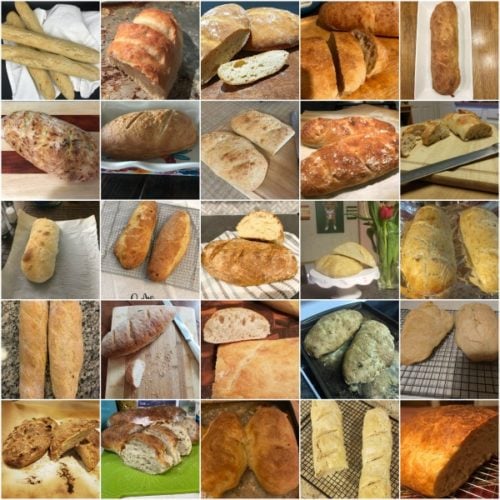
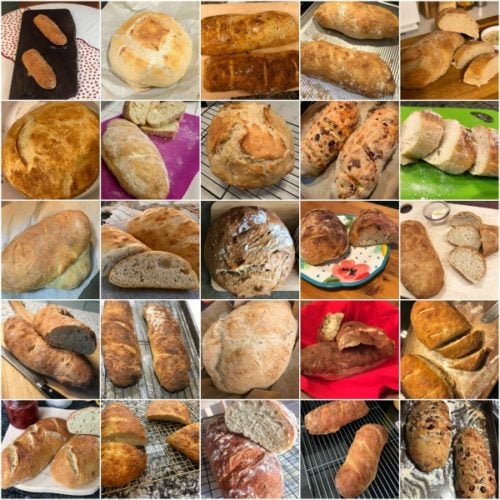
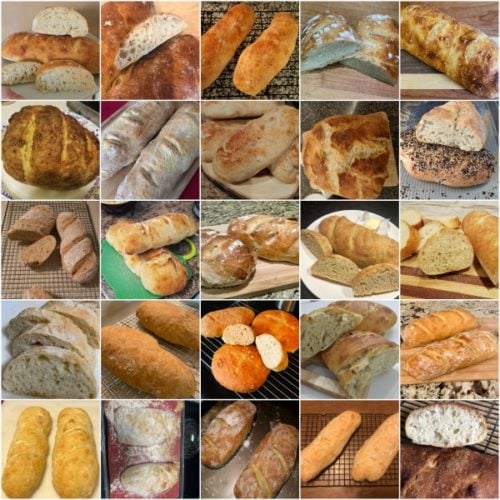
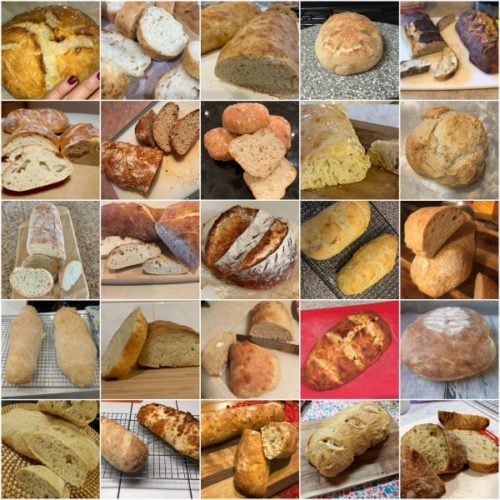
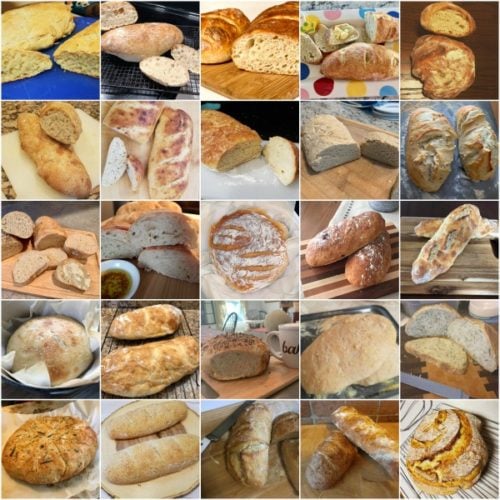
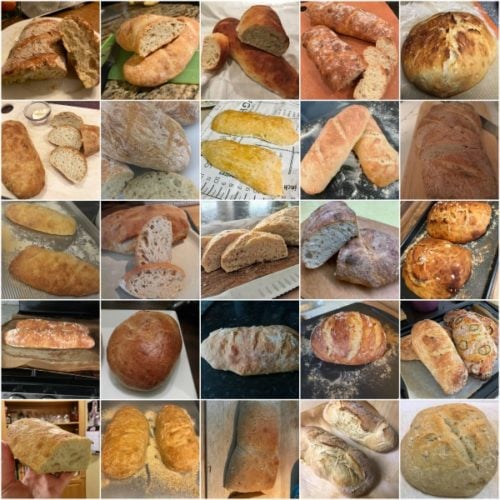
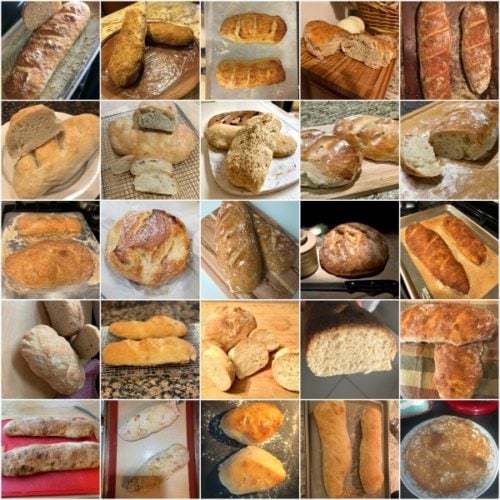
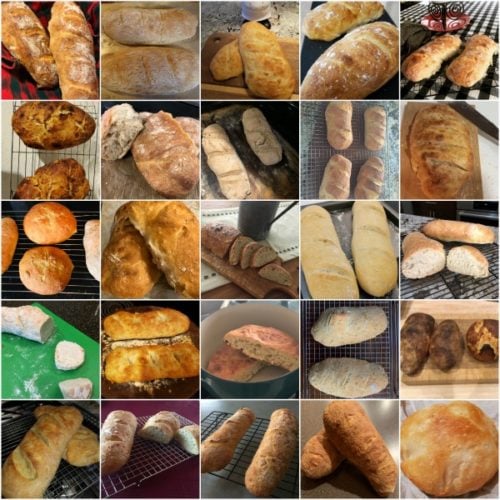
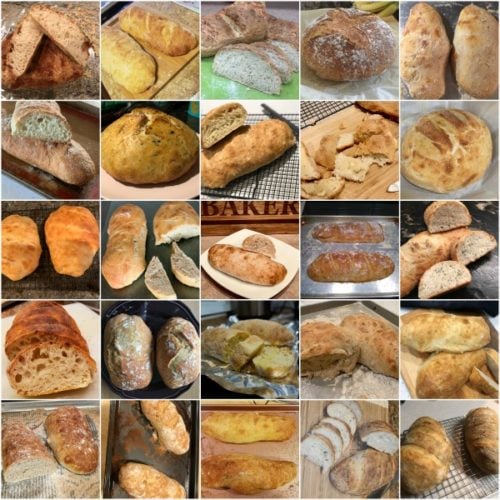
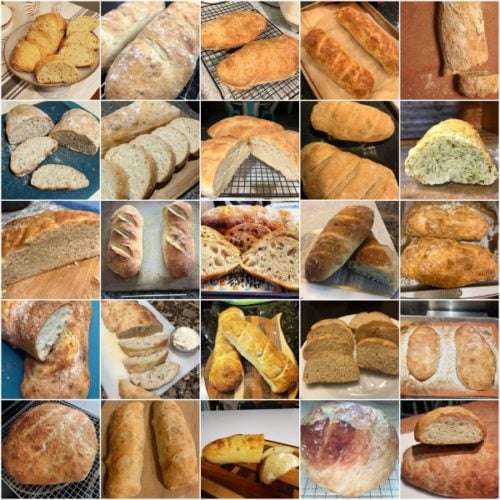
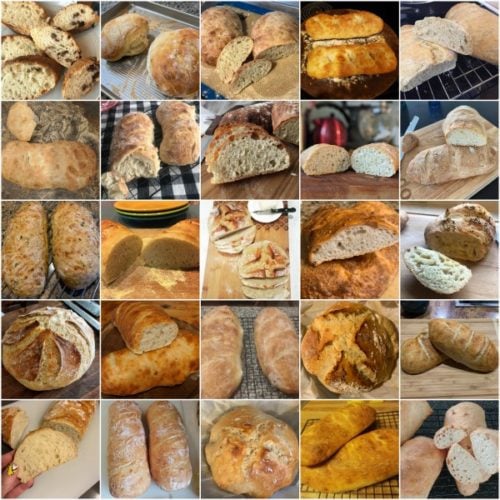

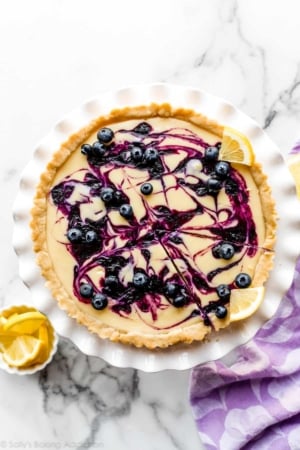
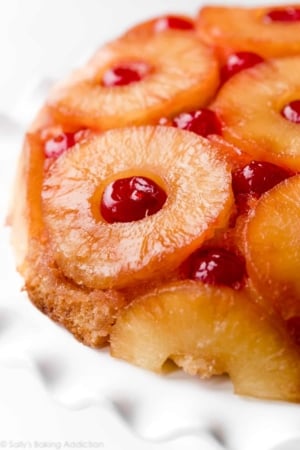
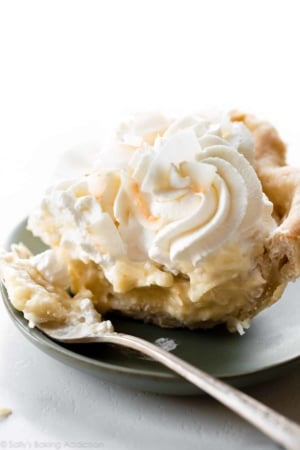

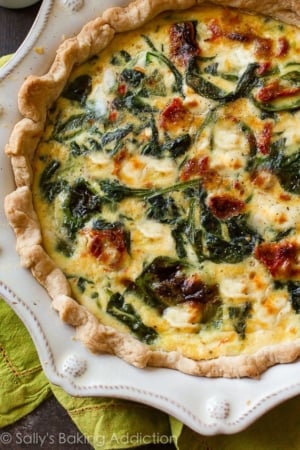
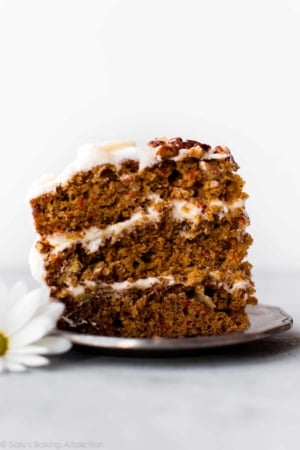






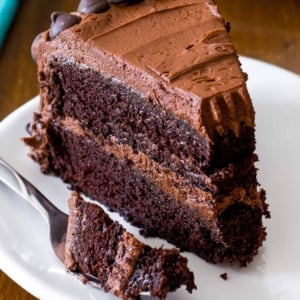

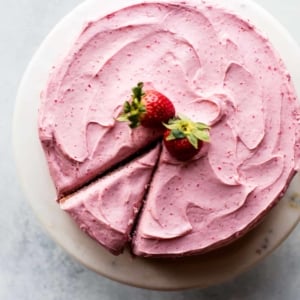

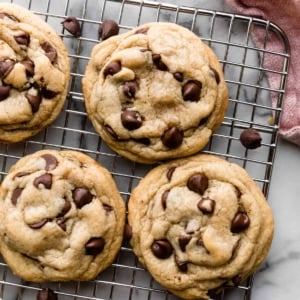
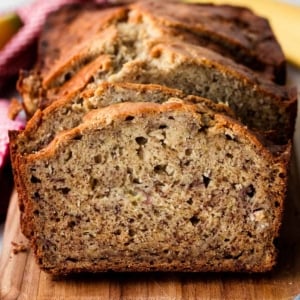
Awesome recipe and so easy. I found the explanation of ways to work with the dough so helpful. My first loaf turned out perfectly. Everyone loved it. I’m making another loaf today. The dough hook on the kitchen aid mixer simplified the process.
Hi sally, would I follow the same recipe if I’m using gluten free all purpose flour? I followed the directions perfectly but my dough never rose!
Hi Jess, we have not tested this recipe with gluten free flour, but you should expect different results if doing so – especially with yeasted breads.
I want to double the recipe so I can make some bread bowls and some sandwich slices. Can I just double the recipe in a single bowl or do I need to make 2 individual batches?
Hi Kelly! We recommend making two batches. Happy baking!
Can you add any kind of sweetener to make this a kinda sweetish bread? Or just savory really?
Hi Kate, Feel free to play around with the recipe and add sweeter additions. You can try adding a little sugar.
I love this recipe. Water and flour isn’t exact I find. But that’s usually how it is with baking. Bread always comes out awesome. Any idea about the nutrition on this bread?
Hi Thomas, We don’t usually include nutrition information as it can vary between different brands of the same ingredients. Plus, many recipes have ingredient substitutions or optional ingredients listed. However, there are many handy online calculators where you can plug in and customize your exact ingredients/brands. Readers have found this one especially helpful: https://www.verywellfit.com/recipe-nutrition-analyzer-4157076
Hi Sally, I have baked bread before, but this recipe outranks any I have tried before, many thanks
My granddaughters friend gave me an artisan loaf. It was the best bread I have tasted. Thank you
What type of bread would you call this? Is it more of a French bread or Italian bread? Mine turned out great but I am hesitant to just call it artisan haha
Recipe was easy to follow and the bread turned out great. I will make another batch today and let it sit in the fridge for 3 days to compare the taste.
Wow!!! SO DELICIOUS! reminds me a bit of ciabatta. Thanks sooo much for putting the weights in metric too. Being from England I’m a bit useless with cups!! Although I do loads of baking and cooking, I had never made bread before as I expected it to take hours and hours. Saw your recipe yesterday and decided to give it a go. Love the fact the proved dough didn’t need ‘knocking back’ and then having to leave to prove again. So easy to make.I would recommend any fellow bread making virgin to give it a go (I have now POPPED MY BREAD MAKING CHERRY (Hahaha ). I couldn’t wait longer than 3 hours because I was desperate to get it done. Was still awesome. A was making a minestrone soup for dinner when my hubby came home from work and had a taste. The taste turned into him munching most of a loaf before my soup was even ready!!! Needless to say there is none left. He begged me to make some more today to go with the lasagne I am making today. I have flavoured the dough with garlic, fresh herbs and some chopped black olives. My mouth is watering already!! I am so glad I came across your site. Thankyou again.
My dough tends to resist shaping – being very elastic and shrinking back each time I try to shape the dough into the loaf shapes. This elasticity also makes it difficult to slash the top before baking. Sometimes I feel like I have to wrestle with the dough to get it to shape the loaves and to slash it. I have tried refrigerator proofing for 18 hours and the full three days – both with the same elasticity issue. The final bake produces a somewhat denser bread but it takes good. Any suggestions to help with these issues? I bake using the steam function of my oven set on Medium steam and need to reduce the temperature by 25 degrees because of my oven. Other than the elasticity and denseness issues, this recipe is a family favorite.
Density and Elasticity of the bread comes from handling it a lot when you first make the dough. Try only handling it til it forms a coherent dough, it doesn’t have to be completely round like a ball and can look a bit shaggy. When you turn out the dough and slice it in two, also try not to touch it too much/handle it a lot, just enough to get the vague shape that you want. Air will always escape but if we can minimize the air loss, the bread will be airy and easy to shape!
Absolutely horrible what a mess never again was just a sticky pile of expensive mess. Too much water in the recipe
This is clearly user error.
I had none of these issues.
This is my husband’s favorite bread recipe that I’ve baked for him. I love how easy it is to make
I do not have a nonstick baking sheet. Will parchment paper on an aluminum sheet work? Thank you.
Ho Joefox, If you don’t have a nonstick baking sheet, line it with parchment paper instead. Coat with a dusting of flour and/or cornmeal before placing the dough on top. Parchment paper can burn, so it’s best to check the box to see how much heat yours can tolerate.
Easy to follow and turned out perfectly crisp on the outside and light & airy on the inside. Flavor is fantastic! Follow instructions and you can’t go wrong! Will make this again and again ! thanks
Hi i don’t have bread flour, instead of doing half bread flour and half whole wheat flour, could i do half all purpose half wheat?
Hi Lola! You risk a denser loaf with those changes.
This is so easy and so delicious! I had herbs and fresh minced garlic! My french boyfriend lovesss the crust and eats it within a day!
Simple and delicious! I followed the recommendation to refrigerate the dough for about 18 hours, then let it sit out for about an hour before popping it in the oven. I added a pan of boiling water and the result was a perfectly crusty exterior and fluffy interior. I will definitely be making this again!
Just made this and OMG! I am a home baker (cakes/cookies) and have always been intimidated by bread making because my previous attempts were failures. I usually don’t have the time or patience for bread making. So this recipe is perfect for me and let me tell you! It’s DELICIOUS! Flavor is so good. I will definitely be making this weekly. Can’t wait to have my sandwich on it tomorrow! Thanks Sally!
Just made this and OMG
I followed this recipe, exactly, and it turned out great.
Also, I added 2 sets of stretches and folds. The bread came out very airy and soft. I did this 3 days ago and the bread is still quite soft and bouncy.
For a first time baker this was very easy, simple and tasty. I love artisan bread and now I’ve converted my husband to artisan bread. Thank you Sally
I was wondering, is it possible to refrigerate from around 8-10 hours and let stand for another 1-2 hours to still achieve a good rise?
Hi Karl, yes, you can definitely try that.
What are the instructions for after cold proofing the dough? Do you bake from cold or bring up to room temperature before baking?
Hi Kat, See step 4 in the recipe instructions. You will shape the dough while it’s cold, and then cover and let it rest for 45 minutes at room temperature before baking.
Love the bread but my dough seems very wet,I have reduced the amount of water slightly but not much difference,can I reduce water a little more?
Hi Anita, this is a very wet dough. There are a lot of variables that can go into the consistency of dough, down to even the weather/humidity. If you find your dough is especially wet/loose, you can certainly add more flour (1 Tablespoon at a time) until the dough comes into a workable consistency. Hope this helps!
Wrap baked, frozen Artisan Bread in foil, place directly on center rack of oven, turn oven to 400 degrees, when fully heated (bell sounds) bake for 18-20 minutes. Remove foil and continue to bake for 5 minutes. Remove bread from oven to a rack to finish baking. Voila, fresh delicious Artisan bread! Adapted from Wildgrain directions for their bread,
Thank you Sally! This turned out amazing for this first time bread baker. I baked it in my Dutch oven and the crust had a delicious crunch compared with the soft middle. Which of your bread recipes should I try next?!
I genuinely make this every week whenever I have guests it slaps so hard. Whoever made this is a genuine godsend
I made this bread and cooked it in an oven-proof cooking pot. It was crusty and awesome!
Ive made 6 loafs of this recipie and its done so well!!!! Im a firat time baker, so this has been fantastic for me
.. i might be ready to move on to something else now. Thanks for this recipie!